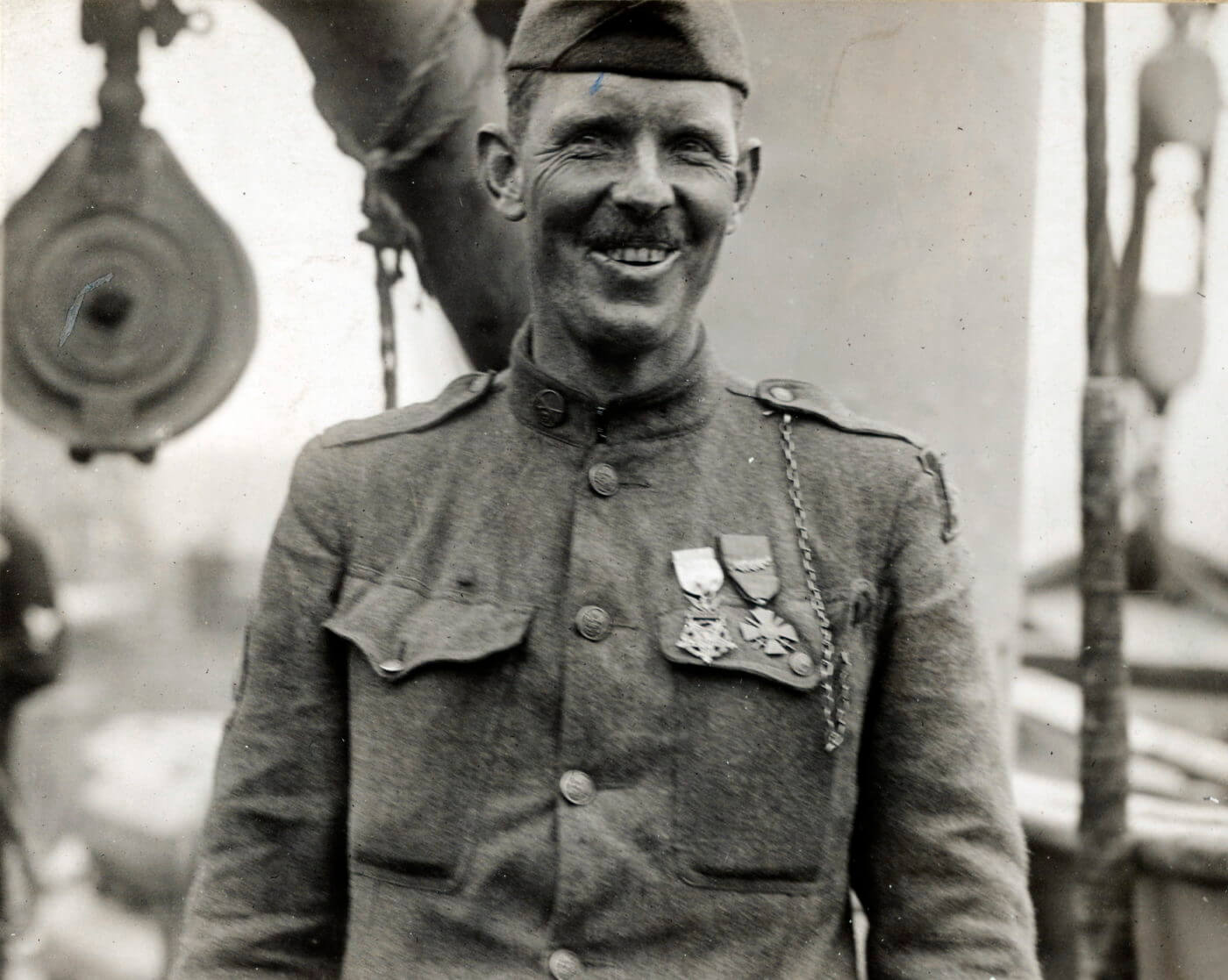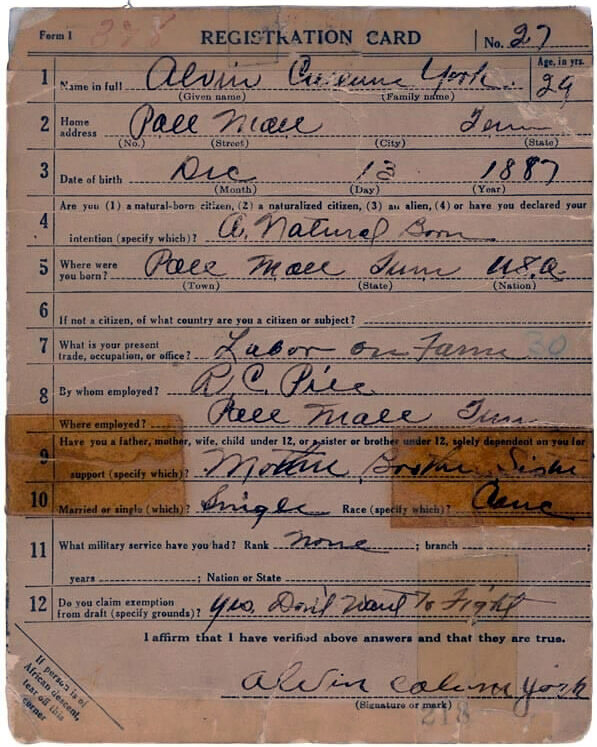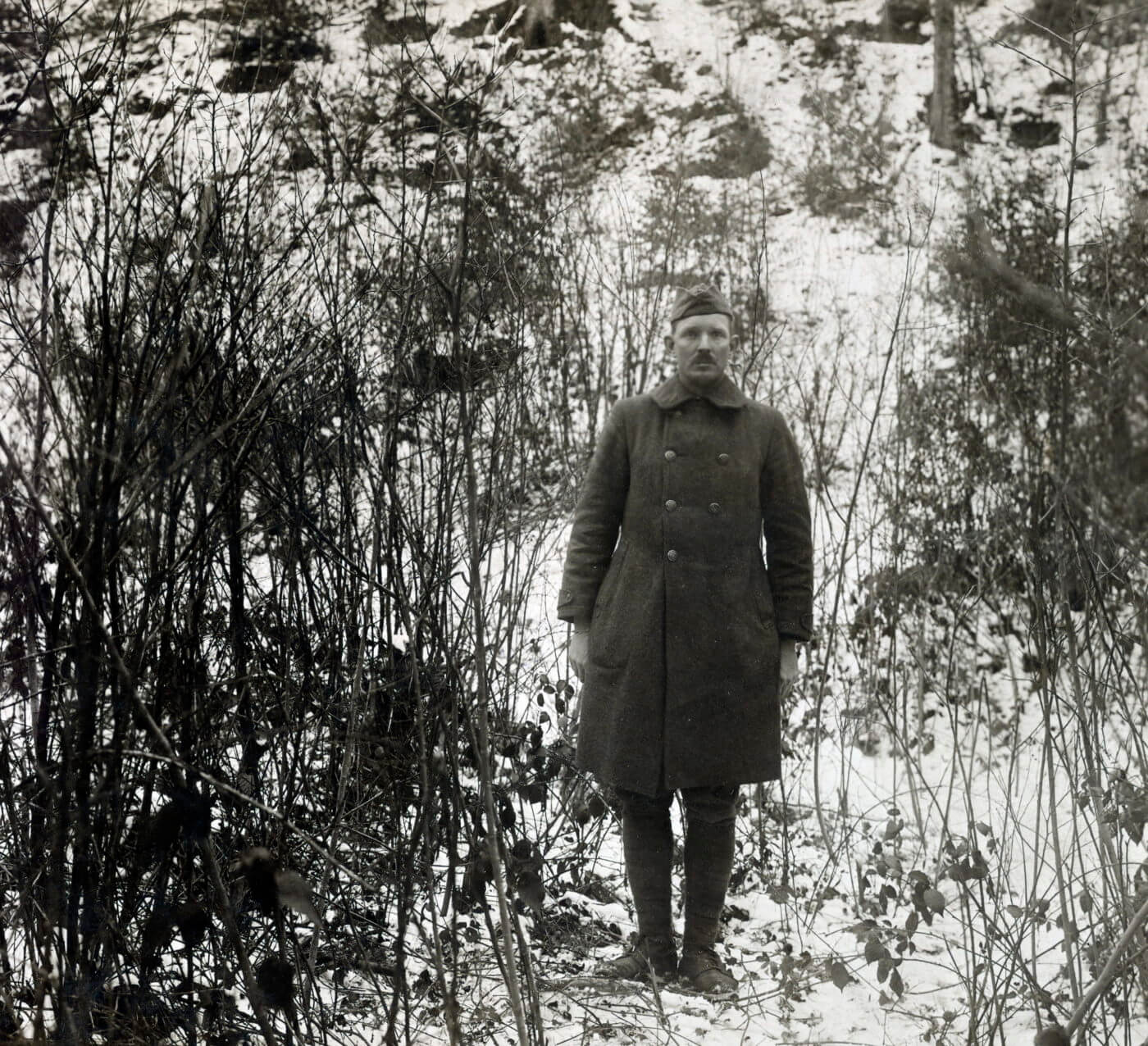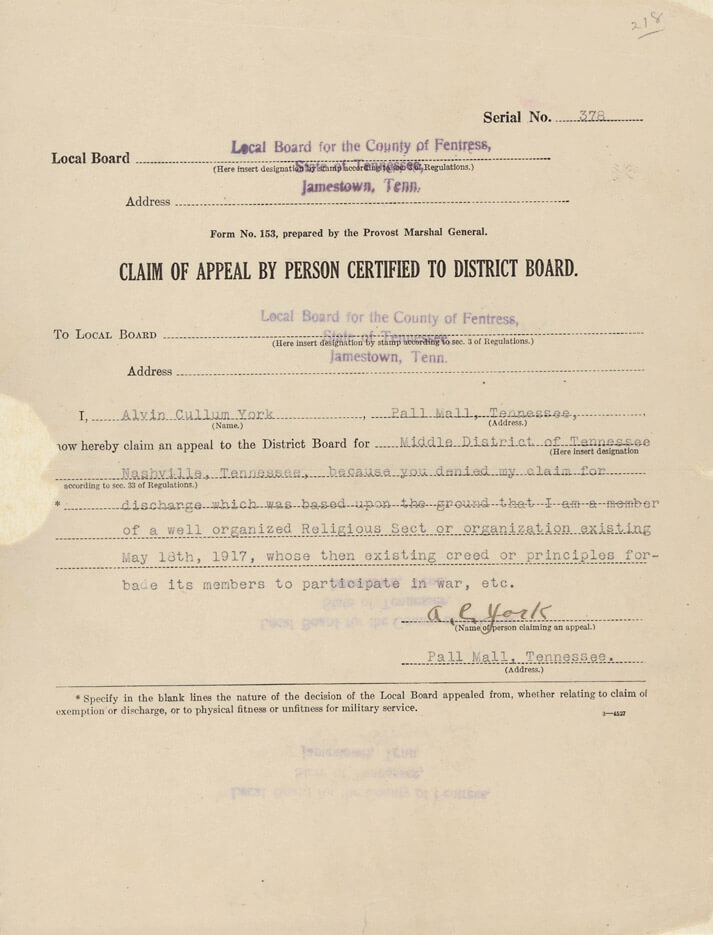Wow!
=====================================
THE LEGEND OF SGT. YORK
er 17th, 2019
6 minute read
The story of Sergeant Alvin York is the stuff of legend. His real-world achievements are beyond the imaginations of Hollywood’s best script doctors. York is one of the most famous American riflemen of all time. He brought the incredible natural accuracy of the American woodsman to the battlefields of France during World War I. However, even though York was an uncanny marksman with a rifle, it was his use of a M1911 pistol that allowed him to survive a bayonet charge counterattack by a squad of Germans.
 Sgt. Alvin York on his return voyage to the United States, wearing the Medal of Honor and the French Croix de Guerre. Image: National ArchiveA Man of Principle
Sgt. Alvin York on his return voyage to the United States, wearing the Medal of Honor and the French Croix de Guerre. Image: National ArchiveA Man of Principle
Alvin York was born in tiny Pall Mall, Tennessee in 1887, the son of a blacksmith and one of 11 children. His family had hunted in the Tennessee woods for generations, and Alvin was one of a long line of natural-born marksmen. With so many mouths to feed in the York family, young Alvin used his hunting skills to put meat on the dinner table. During his early 20s, Alvin became a heavy drinker, gambler, and a bit of a brawler.
In a dramatic transformation, he abandoned his wild ways and became a devout Christian, a regular church goer and even a Sunday school teacher. After his father died, he took over the family blacksmith business. At that point, World War I was nothing more than a distant rumble, far away in Europe.
When the United States entered the war in April of 1917, York found himself in a difficult position. In his opinion the Bible made it clear: “Thou shalt not kill.” York filed a petition with his draft board as a conscientious objector. He was denied. York filed an appeal and was again denied. Subsequently he was drafted and assigned to the 82nd Division at Camp Gordon, Georgia.
His reservations about killing a man still dogged him, and eventually his battalion commander gave York a 10-day pass to go home and resolve the issue in his mind and soul. In the mountain woods near Pall Mall, he got his answer. York would later comment that he received divine inspiration to “go to war and even kill and God would not hold it against me.” Little did the Kaiser’s men know what was about to be unleashed upon them.
As part of Company G of the 328th Infantry, 82nd Division, York had quickly established himself as the best shot in his unit. He found the U.S. Model 1903 Springfield rifle (.30-06) to be quite to his liking. However, as the 82nd Division deployed to France, they were issued the U.S. Model 1917 Enfield rifle (also .30-06). While the M1917 was a fine rifle (and America’s most widely used battle rifle in World War I), York didn’t like it. His son Andrew commented that his father was uncomfortable with the M1917’s peep sight. Apparently, York managed to trade for a Springfield rifle, and he carried the M1903 into combat on that fateful day.
 York’s registration card, containing the phrase “don’t want to fight” written in his own hand.Terror in the Argonne
York’s registration card, containing the phrase “don’t want to fight” written in his own hand.Terror in the Argonne
As the 328th Infantry moved into the Argonne Forest, York (by then a corporal) surveyed the woods and deemed it a place of “abomination and desolation.” The final Allied advance against German positions had reached its critical stage, and the German resistance was fierce. American casualties were already high.
During an attack on Decauville rail line, York’s unit (under the command of Sgt. Bernard Early) came under intense fire from several German machine guns. Sgt. Early and two corporals were badly wounded, leaving York in command. As he and his men were in an exposed position, York maneuvered himself to bring the German machine gunners under fire. He began to systematically eliminate the gunners with accurate fire from his M1903 Springfield rifle. Eventually York crouched or even stood and delivered rapid fire on the German positions, but his rifle ammunition was nearly exhausted.
At this point, a German officer led five men on a bayonet charge towards York’s position. Maybe they had correctly estimated that York was low on or even out of ammo. What they did not predict was that the stubborn American had an M1911 .45 caliber pistol. York dropped down and shot the onrushing Germans the way he would shoot ducks back home — targeting the last man in line first, and then shooting each man from the back of the line to the front. The German officer died last, with his entire squad dead behind him.
With his remaining .30 caliber ammunition, York continued to snipe at German gunners. This proved to be too much for the remaining German officer, who signaled his intention to surrender. Surprisingly, nearly fifty troops came with him. One of the surrendering Germans took a chance and tossed a grenade. It went off and wounded a couple of other Germans, but York was unharmed. Even so, he shot the man that threw the grenade to maintain order among the rest.
 Photograph of York at the base of the hill in the Argonne where his famous action took place, taken February 2, 1919. Image: National Archives
Photograph of York at the base of the hill in the Argonne where his famous action took place, taken February 2, 1919. Image: National Archives
The small group of Americans began to move the much larger gang of German prisoners toward American lines. Along the way, York kept his M1911’s muzzle close against the German officer. As other German troops were encountered, the officer ordered them to surrender. By the time York and his men reached their battalion headquarters, they had accumulated 132 prisoners.
I Surrounded ’em
When York’s battalion commander commented that it looked like he had captured the whole German army, York supposedly replied “No, I only got 132 of them.” When asked how he did it, York simply said “I surrounded ’em.”
For his amazing feat, York was promoted to the rank of sergeant and received the Medal of Honor. The citation reads as follows:
After his platoon suffered heavy casualties and 3 other noncommissioned officers had become casualties, Cpl. York assumed command. Fearlessly leading seven men, he charged with great daring a machine gun nest which was pouring deadly and incessant fire upon his platoon. In this heroic feat the machine gun nest was taken, together with 4 officers and 128 men and several guns.
A rather short and terse assessment of one of the greatest individual achievements in American military history. However, it does fit with York’s humble beginnings. No one would have suspected the hero he would become.
 York’s conscientious objector claim.
York’s conscientious objector claim.
However, any Medal of Honor recommendation has to be investigated, and in 1919, as the Army did their research into York’s actions that day, the skinny sergeant from Tennessee told General Lindsey: “A higher power than man guided and watched over me and told me what to do.”
The Army investigation of the action concluded with a report to General Pershing’s Headquarters that stated: “The part which Corporal York individually played in this attack is difficult to estimate. Practically unassisted, he captured 132 Germans, took about 35 machine guns and killed no less than 25 of the enemy, later to be found by others on the scene of York’s extraordinary exploit. The story has been carefully checked in every possible detail from Headquarters of this Division and is entirely substantiated. Although Corporal York’s statement tends to underestimate the desperate odds which he overcame, it has been decided to forward to higher authority the account given in his own words. The success of this assault has a far-reaching effect in relieving the enemy pressure against American forces in the Argonne Forest.”
Forensic Ballistics
During October 2006, U.S. Army Colonel Douglas Mastriano conducted intensive research to locate the precise location of the York battle site. His team’s findings were incredible. Forensic ballistic analysis verified that the rifle and pistol cartridges recovered matched York’s M1903 rifle and M1911 pistol.
Nearly 90 years after the battle, Mastriano’s team had found the exact location of York’s Medal of Honor action, and the findings corroborated York’s and the official versions of the actions there in 1918. The Mastriano expedition found 46 .30-06 casings and 23 .45 ACP casings — all of which were linked to York’s firearms.
=====================================
THE LEGEND OF SGT. YORK
er 17th, 2019
6 minute read
The story of Sergeant Alvin York is the stuff of legend. His real-world achievements are beyond the imaginations of Hollywood’s best script doctors. York is one of the most famous American riflemen of all time. He brought the incredible natural accuracy of the American woodsman to the battlefields of France during World War I. However, even though York was an uncanny marksman with a rifle, it was his use of a M1911 pistol that allowed him to survive a bayonet charge counterattack by a squad of Germans.

Alvin York was born in tiny Pall Mall, Tennessee in 1887, the son of a blacksmith and one of 11 children. His family had hunted in the Tennessee woods for generations, and Alvin was one of a long line of natural-born marksmen. With so many mouths to feed in the York family, young Alvin used his hunting skills to put meat on the dinner table. During his early 20s, Alvin became a heavy drinker, gambler, and a bit of a brawler.
In a dramatic transformation, he abandoned his wild ways and became a devout Christian, a regular church goer and even a Sunday school teacher. After his father died, he took over the family blacksmith business. At that point, World War I was nothing more than a distant rumble, far away in Europe.
When the United States entered the war in April of 1917, York found himself in a difficult position. In his opinion the Bible made it clear: “Thou shalt not kill.” York filed a petition with his draft board as a conscientious objector. He was denied. York filed an appeal and was again denied. Subsequently he was drafted and assigned to the 82nd Division at Camp Gordon, Georgia.
His reservations about killing a man still dogged him, and eventually his battalion commander gave York a 10-day pass to go home and resolve the issue in his mind and soul. In the mountain woods near Pall Mall, he got his answer. York would later comment that he received divine inspiration to “go to war and even kill and God would not hold it against me.” Little did the Kaiser’s men know what was about to be unleashed upon them.
As part of Company G of the 328th Infantry, 82nd Division, York had quickly established himself as the best shot in his unit. He found the U.S. Model 1903 Springfield rifle (.30-06) to be quite to his liking. However, as the 82nd Division deployed to France, they were issued the U.S. Model 1917 Enfield rifle (also .30-06). While the M1917 was a fine rifle (and America’s most widely used battle rifle in World War I), York didn’t like it. His son Andrew commented that his father was uncomfortable with the M1917’s peep sight. Apparently, York managed to trade for a Springfield rifle, and he carried the M1903 into combat on that fateful day.

As the 328th Infantry moved into the Argonne Forest, York (by then a corporal) surveyed the woods and deemed it a place of “abomination and desolation.” The final Allied advance against German positions had reached its critical stage, and the German resistance was fierce. American casualties were already high.
During an attack on Decauville rail line, York’s unit (under the command of Sgt. Bernard Early) came under intense fire from several German machine guns. Sgt. Early and two corporals were badly wounded, leaving York in command. As he and his men were in an exposed position, York maneuvered himself to bring the German machine gunners under fire. He began to systematically eliminate the gunners with accurate fire from his M1903 Springfield rifle. Eventually York crouched or even stood and delivered rapid fire on the German positions, but his rifle ammunition was nearly exhausted.
At this point, a German officer led five men on a bayonet charge towards York’s position. Maybe they had correctly estimated that York was low on or even out of ammo. What they did not predict was that the stubborn American had an M1911 .45 caliber pistol. York dropped down and shot the onrushing Germans the way he would shoot ducks back home — targeting the last man in line first, and then shooting each man from the back of the line to the front. The German officer died last, with his entire squad dead behind him.
With his remaining .30 caliber ammunition, York continued to snipe at German gunners. This proved to be too much for the remaining German officer, who signaled his intention to surrender. Surprisingly, nearly fifty troops came with him. One of the surrendering Germans took a chance and tossed a grenade. It went off and wounded a couple of other Germans, but York was unharmed. Even so, he shot the man that threw the grenade to maintain order among the rest.

The small group of Americans began to move the much larger gang of German prisoners toward American lines. Along the way, York kept his M1911’s muzzle close against the German officer. As other German troops were encountered, the officer ordered them to surrender. By the time York and his men reached their battalion headquarters, they had accumulated 132 prisoners.
I Surrounded ’em
When York’s battalion commander commented that it looked like he had captured the whole German army, York supposedly replied “No, I only got 132 of them.” When asked how he did it, York simply said “I surrounded ’em.”
For his amazing feat, York was promoted to the rank of sergeant and received the Medal of Honor. The citation reads as follows:
After his platoon suffered heavy casualties and 3 other noncommissioned officers had become casualties, Cpl. York assumed command. Fearlessly leading seven men, he charged with great daring a machine gun nest which was pouring deadly and incessant fire upon his platoon. In this heroic feat the machine gun nest was taken, together with 4 officers and 128 men and several guns.
A rather short and terse assessment of one of the greatest individual achievements in American military history. However, it does fit with York’s humble beginnings. No one would have suspected the hero he would become.

However, any Medal of Honor recommendation has to be investigated, and in 1919, as the Army did their research into York’s actions that day, the skinny sergeant from Tennessee told General Lindsey: “A higher power than man guided and watched over me and told me what to do.”
The Army investigation of the action concluded with a report to General Pershing’s Headquarters that stated: “The part which Corporal York individually played in this attack is difficult to estimate. Practically unassisted, he captured 132 Germans, took about 35 machine guns and killed no less than 25 of the enemy, later to be found by others on the scene of York’s extraordinary exploit. The story has been carefully checked in every possible detail from Headquarters of this Division and is entirely substantiated. Although Corporal York’s statement tends to underestimate the desperate odds which he overcame, it has been decided to forward to higher authority the account given in his own words. The success of this assault has a far-reaching effect in relieving the enemy pressure against American forces in the Argonne Forest.”
Forensic Ballistics
During October 2006, U.S. Army Colonel Douglas Mastriano conducted intensive research to locate the precise location of the York battle site. His team’s findings were incredible. Forensic ballistic analysis verified that the rifle and pistol cartridges recovered matched York’s M1903 rifle and M1911 pistol.
Nearly 90 years after the battle, Mastriano’s team had found the exact location of York’s Medal of Honor action, and the findings corroborated York’s and the official versions of the actions there in 1918. The Mastriano expedition found 46 .30-06 casings and 23 .45 ACP casings — all of which were linked to York’s firearms.

